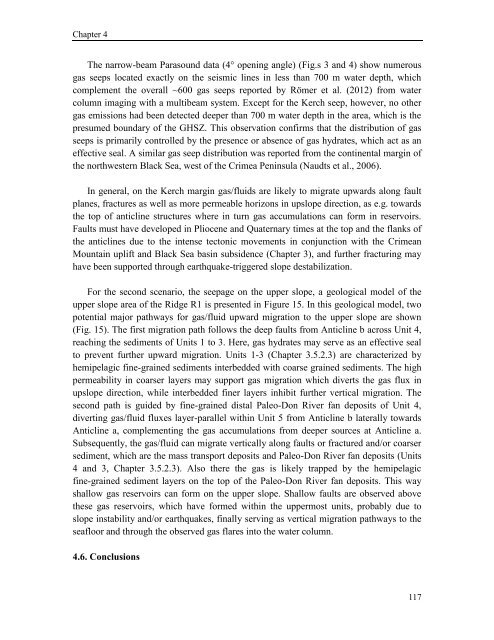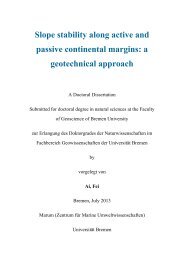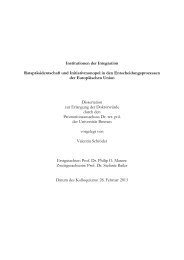Seismoacoustic Study of the Shallow Gas Transport and ... - E-LIB
Seismoacoustic Study of the Shallow Gas Transport and ... - E-LIB
Seismoacoustic Study of the Shallow Gas Transport and ... - E-LIB
Create successful ePaper yourself
Turn your PDF publications into a flip-book with our unique Google optimized e-Paper software.
Chapter 4<br />
The narrow-beam Parasound data (4° opening angle) (Fig.s 3 <strong>and</strong> 4) show numerous<br />
gas seeps located exactly on <strong>the</strong> seismic lines in less than 700 m water depth, which<br />
complement <strong>the</strong> overall ~600 gas seeps reported by Römer et al. (2012) from water<br />
column imaging with a multibeam system. Except for <strong>the</strong> Kerch seep, however, no o<strong>the</strong>r<br />
gas emissions had been detected deeper than 700 m water depth in <strong>the</strong> area, which is <strong>the</strong><br />
presumed boundary <strong>of</strong> <strong>the</strong> GHSZ. This observation confirms that <strong>the</strong> distribution <strong>of</strong> gas<br />
seeps is primarily controlled by <strong>the</strong> presence or absence <strong>of</strong> gas hydrates, which act as an<br />
effective seal. A similar gas seep distribution was reported from <strong>the</strong> continental margin <strong>of</strong><br />
<strong>the</strong> northwestern Black Sea, west <strong>of</strong> <strong>the</strong> Crimea Peninsula (Naudts et al., 2006).<br />
In general, on <strong>the</strong> Kerch margin gas/fluids are likely to migrate upwards along fault<br />
planes, fractures as well as more permeable horizons in upslope direction, as e.g. towards<br />
<strong>the</strong> top <strong>of</strong> anticline structures where in turn gas accumulations can form in reservoirs.<br />
Faults must have developed in Pliocene <strong>and</strong> Quaternary times at <strong>the</strong> top <strong>and</strong> <strong>the</strong> flanks <strong>of</strong><br />
<strong>the</strong> anticlines due to <strong>the</strong> intense tectonic movements in conjunction with <strong>the</strong> Crimean<br />
Mountain uplift <strong>and</strong> Black Sea basin subsidence (Chapter 3), <strong>and</strong> fur<strong>the</strong>r fracturing may<br />
have been supported through earthquake-triggered slope destabilization.<br />
For <strong>the</strong> second scenario, <strong>the</strong> seepage on <strong>the</strong> upper slope, a geological model <strong>of</strong> <strong>the</strong><br />
upper slope area <strong>of</strong> <strong>the</strong> Ridge R1 is presented in Figure 15. In this geological model, two<br />
potential major pathways for gas/fluid upward migration to <strong>the</strong> upper slope are shown<br />
(Fig. 15). The first migration path follows <strong>the</strong> deep faults from Anticline b across Unit 4,<br />
reaching <strong>the</strong> sediments <strong>of</strong> Units 1 to 3. Here, gas hydrates may serve as an effective seal<br />
to prevent fur<strong>the</strong>r upward migration. Units 1-3 (Chapter 3.5.2.3) are characterized by<br />
hemipelagic fine-grained sediments interbedded with coarse grained sediments. The high<br />
permeability in coarser layers may support gas migration which diverts <strong>the</strong> gas flux in<br />
upslope direction, while interbedded finer layers inhibit fur<strong>the</strong>r vertical migration. The<br />
second path is guided by fine-grained distal Paleo-Don River fan deposits <strong>of</strong> Unit 4,<br />
diverting gas/fluid fluxes layer-parallel within Unit 5 from Anticline b laterally towards<br />
Anticline a, complementing <strong>the</strong> gas accumulations from deeper sources at Anticline a.<br />
Subsequently, <strong>the</strong> gas/fluid can migrate vertically along faults or fractured <strong>and</strong>/or coarser<br />
sediment, which are <strong>the</strong> mass transport deposits <strong>and</strong> Paleo-Don River fan deposits (Units<br />
4 <strong>and</strong> 3, Chapter 3.5.2.3). Also <strong>the</strong>re <strong>the</strong> gas is likely trapped by <strong>the</strong> hemipelagic<br />
fine-grained sediment layers on <strong>the</strong> top <strong>of</strong> <strong>the</strong> Paleo-Don River fan deposits. This way<br />
shallow gas reservoirs can form on <strong>the</strong> upper slope. <strong>Shallow</strong> faults are observed above<br />
<strong>the</strong>se gas reservoirs, which have formed within <strong>the</strong> uppermost units, probably due to<br />
slope instability <strong>and</strong>/or earthquakes, finally serving as vertical migration pathways to <strong>the</strong><br />
seafloor <strong>and</strong> through <strong>the</strong> observed gas flares into <strong>the</strong> water column.<br />
4.6. Conclusions<br />
117
















